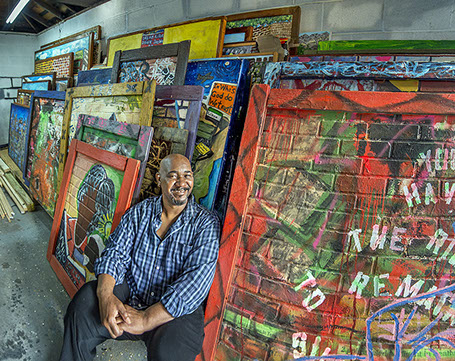Michelangelo Lovelace
2015 MID-CAREER PRIZE IN VISUAL ARTS
Throughout all of the turmoil of trying to escape the downward cycle of poverty, self-doubt, and the street hustler’s life, Michelangelo Lovelace was sustained by his dream of becoming a famous artist, such as Picasso, Van Gogh or, well, Michelangelo.
“I had this fantasy that I kept feeding like a big monster,” he reveals in his dining room, surrounded by his canvases covering every wall of his home like his mentor, the late Rev. Albert Wagner.
“Now I know dreams can come true if I believe in myself.”

That dream was deferred for most of his first two decades, as he made his way through the Cleveland Public Schools, until dropping out of East Technical High School at 16. He continued to try to separate himself from the streets by making money however he could, illegally at times or by cutting grass, shoveling snow, or even caddying at Beechmont Country Club. “No matter what was going on, I always drew, because drawing just came naturally to me,” Michelangelo says.
After viewing his drawings, friends continued to tell him he could be an artist, so he began to take art more seriously. He spent some of his hard-earned money on books about those famous artists. At 22, circumstances left him with sole custody of his children,
so he enrolled at Tri-C Metro to earn his GED and take some classes. Years of his friends’ calling him Michelangelo instead of Michael Anthony, led him to legally change his name, boldly declaring his intention to be an artist.
He applied to the Cleveland Institute of Art and was accepted in 1985. He enjoyed his classes, but once again, trying to pay for tuition and arts supplies while raising his kids on welfare and food stamps yanked him back to the streets a year and a half later. But not before one of his painting professors, Catherine Redmond, took him out to lunch and gave him the greatest advice he’s ever gotten: Paint through your problems. Use them for subject matter and as a way to express yourself. Just don’t stop painting.
All through his continued struggles – two bankruptcies, three divorces, an unsuccessful move to LA, and the death of a young son, his best friend and later his mother – he painted. Early on, he tried abstractions, but says: “For whatever reason, I couldn’t express what I was going through with abstraction.”
Believing no one could possibly care about poor people, the projects or street life, he avoided painting what he saw and experienced on a daily basis. He tried painting jazz musicians, landscapes and people’s homes, anything people would buy for $25 or $50. “I got no satisfaction out of that,” he confirms. So, he finally painted his family and friends to populate his
colorful, whimsical and raw neighborhood scenes.
“For the past 20 years, Mike has continued to interpret what he sees in and how he feels about Cleveland,” says artist Omar Shaheed, a friend and former Clevelander before moving to Columbus. “He’s got a lot of integrity
in his work, and I see him going a
long way.”
Michelangelo moved into the Hodge School Complex for artists in 1992, and by the late ‘90s, a couple of Ohio Arts Council grants bolstered his confidence. Through the late David Roth’s Cleveland Works program, he acquired the training to become a nurse’s aide to subsidize his painting.
He went on to many successes, including having pieces in the collections of the Cleveland Clinic, Progressive Insurance and the Western Reserve Artist Archives. His paintings have been exhibited in Baltimore, Chicago, New York and throughout Ohio, and the Maria Neil Art Project in Collinwood helps promote his work. In 2013, he received
a Community Partnership for Arts & Culture Creative Workforce Fellowship.
Now, he works as a nurse’s aide in Skill Rehabilitation Unit 6A at MetroHealth Medical Center by day and comes home to paint and handle marketing and promotions tasks. He estimates that he still has 500 paintings or more that he wants to create, dealing with personal and current social issues.
“I have so many more things that I need to say,” Michelangelo concludes. “And painting feeds the need in me to feel alive and important and to see my ideas come to life.”
See Lovelace’s work at MOCA this summer in a group exhibition, “How to Remain Human”.
Cleveland Arts Prize
P.O. Box 21126 • Cleveland, OH 44121 • 440-523-9889 • info@clevelandartsprize.org